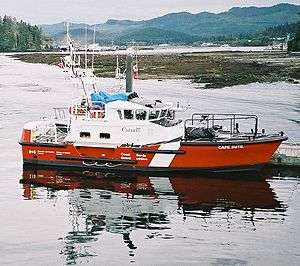CCGS Cape Naden
 Sister ship, CCGC Cape Sutil at CCG Station Port Hardy. | |
| History | |
|---|---|
| Name: | Cape Naden |
| Operator: | Canadian Coast Guard |
| Builder: | Victoria Shipyards, Victoria, BC |
| Commissioned: | 2011 |
| Homeport: | Pat Bay |
| Status: | in active service |
| General characteristics | |
| Class and type: | Cape Class lifeboat |
| Type: | SAR Lifeboat |
| Displacement: | 33.8 grt |
| Length: | 14.6 m (47 ft 11 in) |
| Beam: | 4.27 m (14 ft 0 in) |
| Draft: | 1.37 m (4 ft 6 in) |
| Speed: | 25 knots (46 km/h; 29 mph) |
| Range: | 200 nmi (370 km; 230 mi) |
| Endurance: | 1 day |
| Complement: | 4 |
The CCGS Cape Naden is one of the Canadian Coast Guard's 36 Cape class motor life boat.[1] The Cape Naden was built in the Victoria Shipyards, in Vancouver. Keith Ashfield Canada's Minister of Fisheries and Oceans and Minister for the Atlantic Gateway officiated at the vessel's dedication at Pat Bay.
Design
Like all Cape-class motor lifeboats, Cape Naden has a displacement of 20 short tons (18 t) and a total length of 47 feet 11 inches (14.61 m) and a beam length of 14 feet (4.3 m).[2] Constructed from marine-grade aluminium, it has a draught length of 4 feet 6 inches (1.37 m). It contains two computer-operated Detroit DDEC-III 6V-92TA diesel engines providing a combined 870 shaft horsepower. It has two 28 by 36 inches (710 mm × 910 mm) four-blade propellers, and its complement is four crew members and five passengers.[2]
The lifeboat has a maximum speed of 25 knots (46 km/h; 29 mph) and a cruising speed of 22 knots (25 mph). Cape-class lifeboats have fuel capacities of 400 US gallons (1,500 l; 330 imp gal) and ranges of 200 nautical miles (370 km; 230 mi) when cruising.[2] Cape Naden is capable of operating at wind speeds of 50 knots (93 km/h; 58 mph) and wave heights of 30 feet (9.1 m). It can tow ships with displacements of up to 150 tonnes (170 short tons) and can withstand 60 knots (110 km/h; 69 mph) winds and 20 feet (6.1 m)-high breaking waves.[2]
Communication options include Raytheon 152 HF-SSB and Motorola Spectra 9000 VHF50W radios, and a Raytheon RAY 430 loudhailer system.[2] The boat also supports the Simrad TD-L1550 VHF-FM radio direction finder. Raytheon provides a number of other electronic systems for the lifeboat, including the RAYCHART 620, the ST 30 heading indicator and ST 50 depth indicator, the NAV 398 global positioning system, a RAYPILOT 650 autopilot system, and either the R41X AN or SPS-69 radar systems.[2]
References
- ↑ "Coast guard christens new vessel". Canadian Coast Guard. 2011-07-22. Retrieved 2011-12-03.
- 1 2 3 4 5 6 "Motor Life Boat 47-Foot MLB: International Affairs (CG-DCO-I)". United States Coast Guard, Department of Homeland Security. 1 July 2015. Retrieved 19 August 2015.